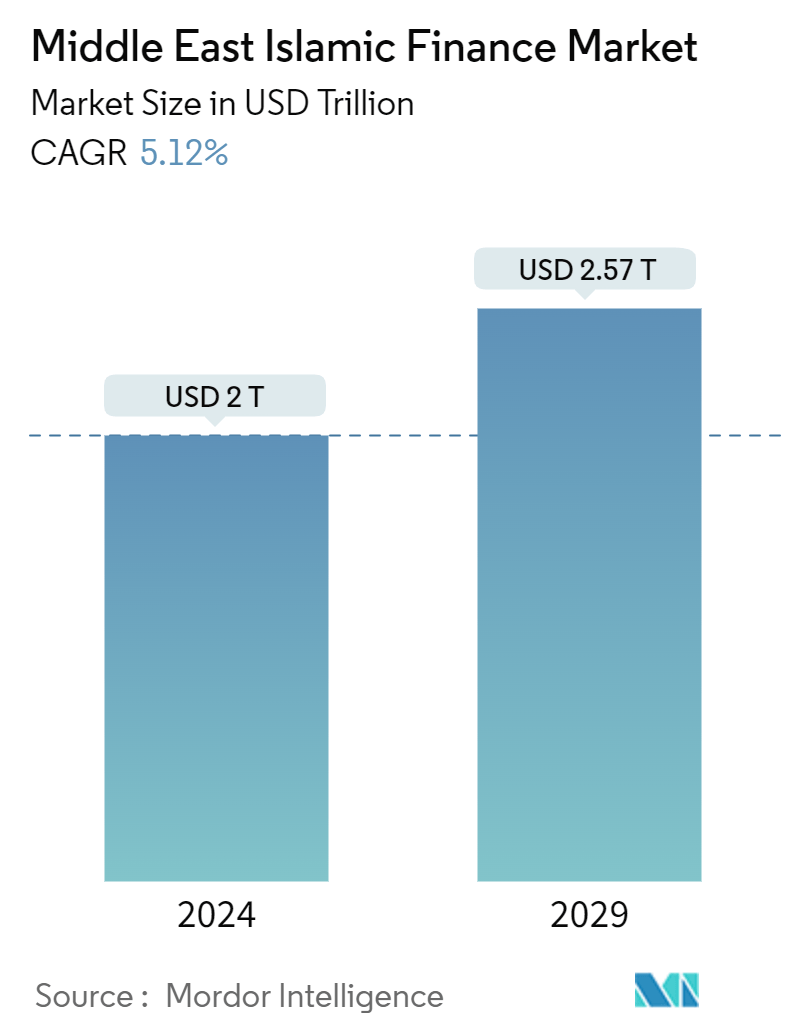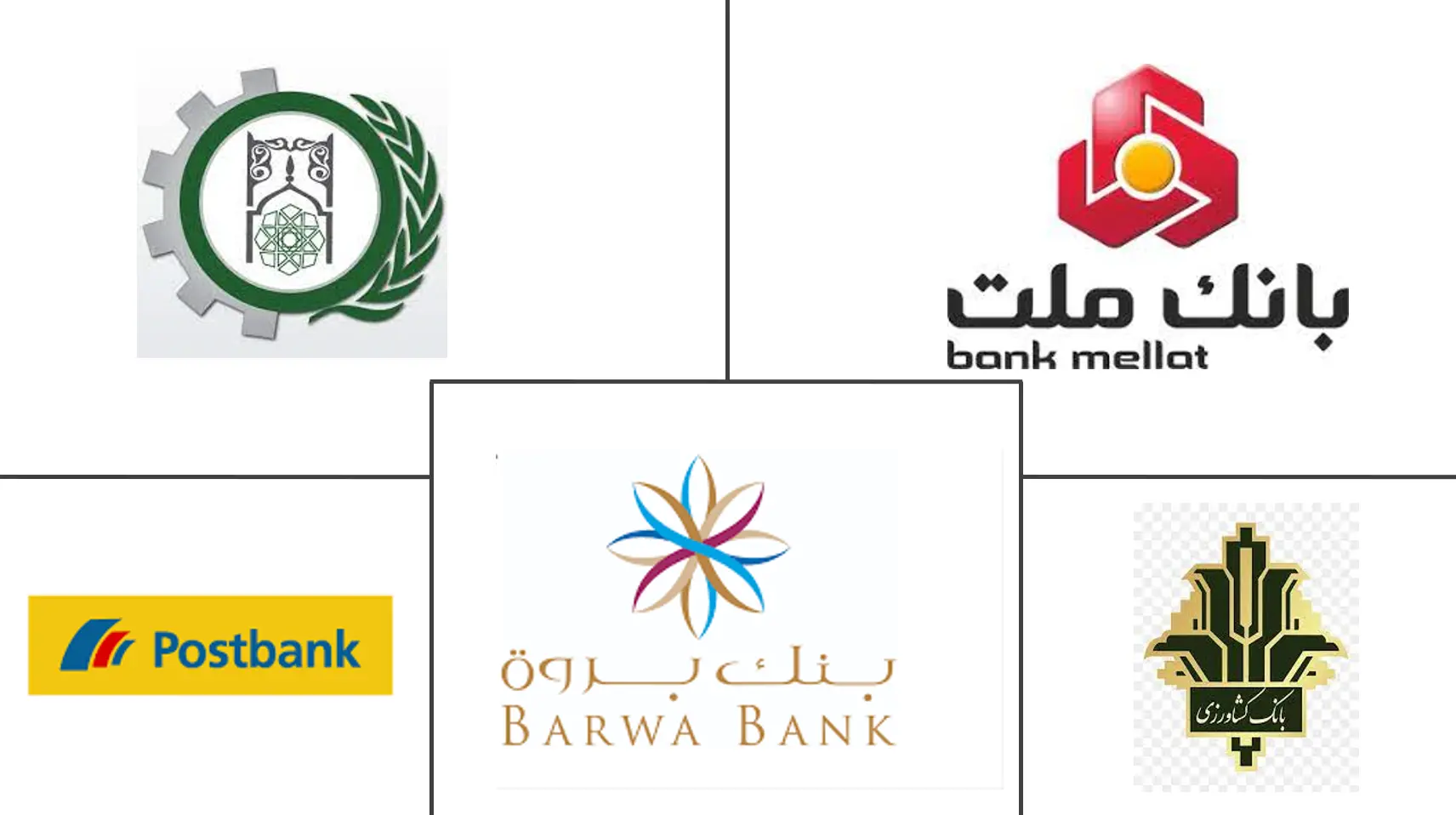Market Size of Middle East Islamic Finance Industry

| Study Period | 2020 - 2029 |
| Market Size (2024) | USD 2 Trillion |
| Market Size (2029) | USD 2.57 Trillion |
| CAGR (2024 - 2029) | 5.12 % |
| Fastest Growing Market | Asia Pacific |
| Largest Market | Middle East and Africa |
Major Players
*Disclaimer: Major Players sorted in no particular order |
Middle East Islamic Finance Market Analysis
The Middle East Islamic Finance Market size is estimated at USD 2 trillion in 2024, and is expected to reach USD 2.57 trillion by 2029, growing at a CAGR of 5.12% during the forecast period (2024-2029).
- The importance of the wider Middle East region continues to be clear, accounting for 77.4% of total Sharia-compliant assets in the latest ranking. Iran and Saudi Arabia remain by far the largest markets when it comes to Sharia-compliant assets, with both markets having more than $400bn in assets.
- Six of the 10 largest Islamic lenders come from those two countries, with only one, Malaysia’s Malayan Banking Berhad (Maybank), coming from outside the Middle East. Islamic finance is deeply rooted in the Middle East, a region that continues to shape the modern Islamic finance industry globally. Commanding the lion's share of global Islamic banking and finance assets and wielding enormous influence in the industry, the Middle East has always been an integral part of Islamic finance.
- The post-COVID scenario of the Middle East Islamic finance market has seen a steady recovery with increased demand for Sharia-compliant financial products and services. Islamic banks have adapted to the new normal by leveraging digital platforms and expanding their offerings. Overall, the market is showing resilience and growth opportunities.
Middle East Islamic Finance Industry Segmentation
Islamic banking, Islamic finance, or Sharia-compliant finance is banking or financing activity that complies with Sharia and its practical application through the development of Islamic economics. Some of the modes of Islamic banking/finance include Mudarabah, Wadiah, Musharaka, Murabahah, and Ijara.
The Middle East Islamic Finance market can be segmented by the financial sector, which includes Islamic banking, Islamic insurance ‘takaful,’ Islamic bonds ‘sukuk,’ other Islamic financial institutions (OIFLs), and Islamic funds and by geography, which includes Saudi Arabia, Qatar, Iraq, Iran, United Arab Emirates and the Rest of Middle East.
The report offers market size and forecasts for the market in value (USD) for all the above segments.
| By Financial Sector | |
| Islamic Banking | |
| Islamic Insurance 'Takaful' | |
| Islamic Bonds 'Sukuk' | |
| Other Financial Institutions (OIFL's) and Islamic Funds |
| By Geography | |
| Saudi Arabia | |
| Qatar | |
| Iraq | |
| Iran | |
| United Arab Emirates | |
| Rest of Middle East |
Middle East Islamic Finance Market Size Summary
The Middle East Islamic finance market is a pivotal segment of the global Islamic finance industry, with the region accounting for a significant portion of Sharia-compliant assets. Iran and Saudi Arabia are the dominant players, hosting a majority of the largest Islamic lenders and holding substantial assets. The region's deep-rooted connection to Islamic finance continues to influence the industry's global landscape. Post-COVID, the market has shown resilience, with Islamic banks embracing digital transformation and expanding their product offerings to meet the growing demand for Sharia-compliant financial services. The Gulf region, in particular, has witnessed a surge in fintech investments, with digital sukuk and fintech companies emerging as key growth drivers.
Iran's established Islamic banking system plays a crucial role in the Middle East Islamic finance market, fostering competition and innovation among regional financial institutions. This competitive environment encourages the development of diverse Islamic financial products, benefiting consumers and stimulating market growth. The market is characterized by the presence of major international players, yet technological advancements and product innovations are enabling mid-size and smaller companies to expand their market presence. Collaborations, such as those between Abu Dhabi Securities Exchange and Sharjah Islamic Bank, highlight ongoing efforts to enhance market accessibility and product offerings, further contributing to the sector's growth trajectory.
Middle East Islamic Finance Market Size - Table of Contents
-
1. MARKET DYNAMICS
-
1.1 Market Overview
-
1.2 Market Drivers
-
1.2.1 Growing Muslim Population is Driving the Market
-
-
1.3 Market Restraints
-
1.3.1 Lack of Standardization and Harmonization across different Jurisdictions
-
-
1.4 Market Opportunities
-
1.4.1 Digital Transformation and Embracing Fintech Innovations
-
-
1.5 Porter's Five Forces Analysis
-
1.5.1 Threat of New Entrants
-
1.5.2 Bargaining Power of Buyers/Consumers
-
1.5.3 Bargaining Power of Suppliers
-
1.5.4 Threat of Substitute Products
-
1.5.5 Intensity of Competitive Rivalry
-
-
1.6 Insights on Technological Advancements in the Market
-
1.7 Impact of COVID-19 on Industry
-
-
2. MARKET SEGMENTATION
-
2.1 By Financial Sector
-
2.1.1 Islamic Banking
-
2.1.2 Islamic Insurance 'Takaful'
-
2.1.3 Islamic Bonds 'Sukuk'
-
2.1.4 Other Financial Institutions (OIFL's) and Islamic Funds
-
-
2.2 By Geography
-
2.2.1 Saudi Arabia
-
2.2.2 Qatar
-
2.2.3 Iraq
-
2.2.4 Iran
-
2.2.5 United Arab Emirates
-
2.2.6 Rest of Middle East
-
-
Middle East Islamic Finance Market Size FAQs
How big is the Middle East Islamic Finance Market?
The Middle East Islamic Finance Market size is expected to reach USD 2 trillion in 2024 and grow at a CAGR of 5.12% to reach USD 2.57 trillion by 2029.
What is the current Middle East Islamic Finance Market size?
In 2024, the Middle East Islamic Finance Market size is expected to reach USD 2 trillion.

